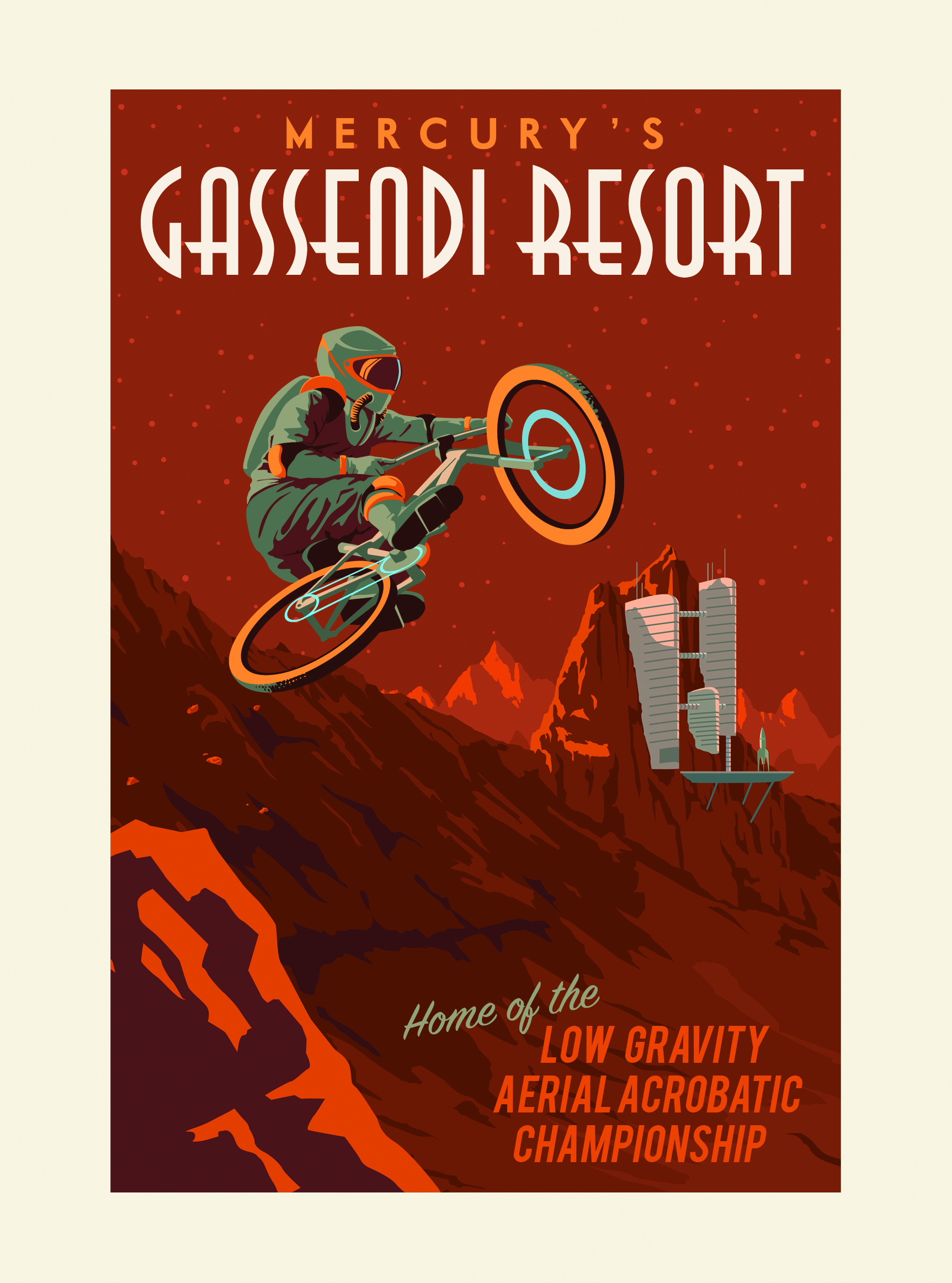



The following is an excerpt from VACATION GUIDE TO THE SOLAR SYSTEM: Science for the Savvy Space Traveler by Olivia Koski and Jana Grcevich.
Watch a Double Sunset
One of the greatest reasons to visit Mercury is to witness the peculiar behavior of the sun in its dark sky. Of course, unless you have a death wish, you won’t be seeing the sun’s dance across the sky firsthand. You’ll be able to safely view—and celebrate—the sun’s acrobatics through an underground telescope. From this unique vantage point, you can watch the sun as it takes its sweet time to pass overhead. There is a special moment each day when it appears to stop and reverse course temporarily, before continuing on its several-Earth-months-long journey to sunset. Depending on where you are on Mercury, the sun may even appear to set and then rise again, as the planet passes through the point of its closest approach to the sun and its angular speed is temporarily faster than its rotation. Take this moment to reflect on the past and think about what you might do if you could turn back time. Forgive old grudges and right any wrongs you’ve committed over the previous Mercurian morning (i.e., year).
When the sun is moving backward in the sky, you may notice that it looks gigantic. Don’t worry, it’s not sun poisoning affecting your judgment. Because of Mercury’s closeness to the sun, the sun does appear larger in the sky than it does from Earth. The planet’s highly elliptical orbit enhances this effect, and the sun will seem to grow and shrink throughout the year. At Mercury’s closest approach, 29 million miles—known as perihelion—the sun looks three times as big as it does on Earth. During aphelion, when Mercury is at its farthest point, 43 million miles from the sun, it only looks about twice as big.
Sail the Solar Wind
Unfurl your reflective sails on a solar sailboat. Photons, or light particles, streaming away from the sun will bounce off the mirror-like surface, giving your ship a miniscule push. The combined effect, called radiation pressure, will let you sail the seven seas of the solar system. You might not accelerate dramatically, but you will slowly gain speed over time until you’re going fast enough to travel astronomical distances. If you get caught in a solar flare, you’ll have to batten down the hatches.
Walk the Eternal Sunset
The primary reason to visit Mercury is the chance to walk its slow-moving terminator line, which divides day and night. Because the planet rotates so slowly, it’s possible to stay ahead of the sunrise. The terminator on Mercury travels at a reasonable walking rate of just 2.2 miles per hour, while the line that divides day and night on Earth travels at around 1,000 miles per hour. The terminator provides dramatic shadows, and this stark safe zone between night and day maintains a surprisingly habitable climate, though the consequences of falling behind can be fatal. Don’t get caught in direct sunlight, or you will be just another lump of human charcoal dotting the Mercurian landscape. Extreme athletes love the challenge of walking the entire 9,500-mile distance around the planet in one shot.
Ski the Volcanic Sands
The fine-grained sands left behind from billion-year-old volcanic eruptions are fantastic for sandboarding and skiing. Low gravity provides the perfect setup for getting major air. There are dozens of these so-called pyroclastic deposits all over the planet, including one in the southwest of the Caloris basin and one west of Copland crater.
Experience the Supernatural Glow of the Exosphere
Mercury’s very tenuous atmosphere, its exosphere, is rich in sodium. When night falls, an amber-yellowish glow encases the sky, like sodium-vapor lights in a parking lot. It will remind you of the auroras back home on Earth, but it diffusely covers the whole sky and is brightest toward the horizon. The light is enough to see by, which is fortunate because all of your surface activity must occur at night.
Visit the Ghost Ships
Scientists lost touch with the first spacecraft to visit, Mariner 10, when it ran out of fuel back in the 1970s and drifted into space. No one has heard from it since. The ghost of Mariner 10 haunts the inner solar system. Legend has it the spacecraft keeps calling to Mercury, still trying to study it, supposedly collecting data and eerily sending it into the void of outer space. You can also see the remnants of another dead ship, the MESSENGER craft, which intentionally crashed into the planet on April 30, 2015. The impact left a crater on the surface fifty-two feet wide.
From VACATION GUIDE TO THE SOLAR SYSTEM: Science for the Savvy Space Traveler by Olivia Koski and Jana Grcevich, published on June 6, 2017 by Penguin Books, an imprint of Penguin Publishing Group, a division of Penguin Random House, LLC. Copyright © 2017 by Olivia Koski, Jana Grcevich, and Guerilla Science, LLC.
Popular Science is delighted to bring you selections from new and noteworthy science-related books. If you are an author or publisher and have a new and exciting book that you think would be a great fit for our website, please get in touch! Send an email to books@popsci.com.
